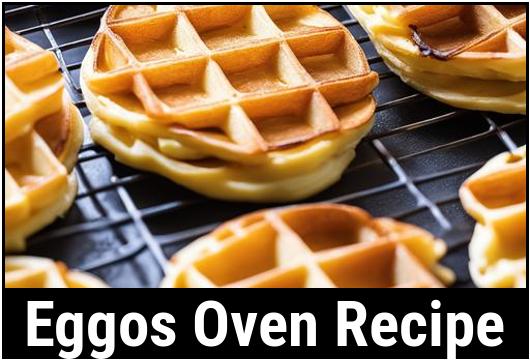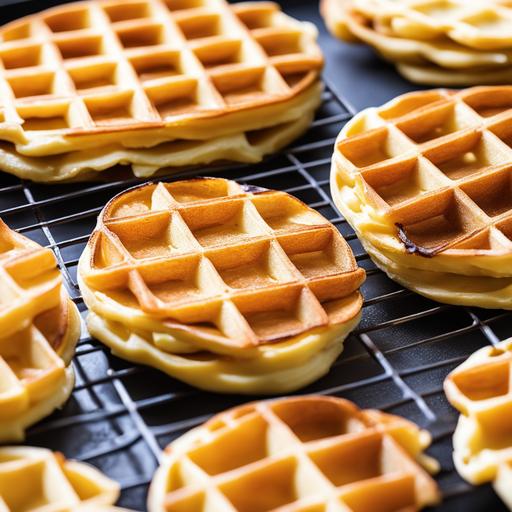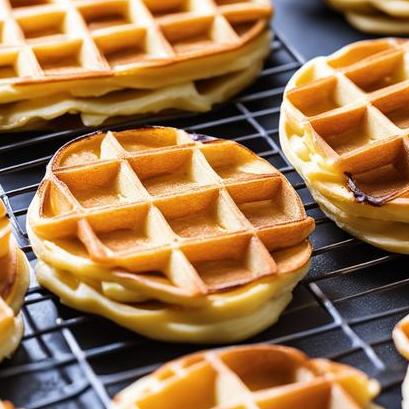- You are here:
- Home »
- Oven Recipes
- » Eggos Oven Recipe: A Comprehensive Guide

Eggos Oven Recipe: A Comprehensive Guide
Eggos are delicious and versatile breakfast treats that are loved by people of all ages. Whether you prefer them plain, with syrup, or topped with fruits and nuts, there’s no denying their appeal. While many people cook Eggos in a toaster, using an oven can elevate the taste and texture to a whole new level. In this comprehensive and in-depth article, we will delve into the world of cooking Eggos in an oven, covering various aspects such as food science, culinary details, selection, cleaning, preparation, tips, variations, doneness checks, and even tackling the issue of overcooking and undercooking. So, let’s get started!
Food Science behind Cooking Eggos in an Oven
To understand the science of cooking Eggos in an oven, we need to delve into the concept of heat transfer. Ovens use both convection and radiant heat to cook food. When you place your Eggos in the oven, the hot air circulates around them, cooking them from all sides evenly. This leads to a more uniform and crispy texture compared to using a toaster, where heat is primarily applied from one direction.
Moreover, Eggos contain ingredients like flour, sugar, and fat. When exposed to heat, these ingredients undergo chemical reactions that contribute to the browning and overall flavor development. This "Maillard reaction" is responsible for creating complex flavors and enhancing the taste of your Eggos.
Selecting the Perfect Eggos for Oven Cooking
Before you embark upon your culinary adventure with Eggos in the oven, it’s essential to choose the right type of Eggos. While there are various flavors available in the market, it’s recommended to opt for the classic buttermilk Eggos as they provide a great base for experimenting with different toppings and flavors.
Ensure that the Eggos you select are frozen and not thawed. Frozen Eggos retain their shape and consistency better during the baking process, resulting in a crisp exterior and a soft, fluffy interior.
Cleaning and Preparing Your Oven

Cleanliness is paramount when it comes to preparing any food item, and your oven is no exception. Before starting the cooking process, thoroughly clean your oven to remove any residue or spillage from previous usage. Not only does this promote food safety, but it also prevents any unwanted odors or flavors from transferring to your Eggos.
Preparation and Tips for Oven-Baked Eggos

-
Preheat your oven: Set the oven to 375°F (190°C) and allow it to preheat. This ensures that the Eggos cook evenly and consistently.
-
Prepare a baking sheet: Line a baking sheet with parchment paper or lightly grease it with cooking spray to prevent the Eggos from sticking.
-
Arrange the Eggos: Place the frozen Eggos on the prepared baking sheet, ensuring there is sufficient space between each piece. This allows for better air circulation and even cooking.
-
Achieving a golden-brown perfection: For a perfectly golden-brown exterior, brush the tops of the Eggos with melted butter or egg wash before placing them in the oven. This will give them an irresistible shine and extra flavor.
-
Flipping for even cooking: After around 5-6 minutes of baking, carefully flip the Eggos using a spatula or tongs. This ensures both sides cook evenly, resulting in consistent browning.
-
Adding toppings and variations: Once your Eggos are cooked to perfection, it’s time to get creative with toppings. Explore a variety of options such as maple syrup, fresh fruits, whipped cream, chocolate chips, or even savory toppings like bacon and cheese.
Checking for Doneness and Avoiding Undercooking or Overcooking

Accurately determining the doneness of your Eggos is crucial to ensure they are cooked to perfection without being undercooked or overcooked. Here are some tips to help you achieve the ideal crispness:
-
Visual cues: Keep an eye on the color of your Eggos. They should turn a beautiful golden-brown, indicating that the exterior is crisp while the interior remains soft and fluffy.
-
Stiffness test: Gently press the center of an Eggo with your finger. It should feel firm and springy, indicating that it is cooked through.
-
Temperature check: For precise doneness, you can use a food thermometer. Insert it into the center of an Eggo, and it should register between 165°F-175°F (74°C-79°C), ensuring it is fully cooked.
Be cautious not to overcook your Eggos as this can result in a dry and tough texture. Keep a close eye on them and remove them from the oven once they reach the desired level of doneness.
Recipe for Oven-Baked Eggos

Now that we have covered the scientific insights, tips, and tricks, it’s time to dive into a delicious recipe for baking Eggos in the oven. This simple recipe serves as a great starting point for you to experiment with various flavors and toppings.
Ingredients:
-
4 classic buttermilk Eggos
-
Melted butter or egg wash (optional)
-
Toppings of your choice (maple syrup, fresh fruits, etc.)
Instructions:
-
Preheat your oven to 375°F (190°C) and line a baking sheet with parchment paper or lightly grease it.
-
Place the frozen Eggos on the prepared baking sheet, making sure to provide enough space between each piece.
-
Optionally, brush the tops of the Eggos with melted butter or egg wash for extra flavor and shine.
-
Bake the Eggos for approximately 10-12 minutes, flipping them after 5-6 minutes to ensure even cooking. Keep a close eye on them to prevent overcooking.
-
Once they are golden-brown and crispy, remove the Eggos from the oven.
-
Serve the oven-baked Eggos hot with your favorite toppings such as maple syrup, fresh fruits, or any other imaginative creation you desire.
Variations and Creative Ideas
While the classic buttermilk Eggos are a fantastic base, don’t be afraid to try out different flavors and variations. Here are some ideas to experiment with:
-
Chocolate Lover’s Delight: Use chocolate chip Eggos and top them with a drizzle of chocolate syrup, whipped cream, and a sprinkle of cocoa powder for an indulgent treat.
-
Fruity Bliss: Opt for blueberry or strawberry Eggos and garnish them with fresh berries, a dollop of Greek yogurt, and a dusting of powdered sugar.
-
Savory Sensations: Explore the savory side by using savory-flavored Eggos like bacon and cheese. Top them with crispy bacon bits, shredded cheese, and a poached egg for a unique brunch experience.
-
Ice Cream Dream: Take your oven-baked Eggos to the next level by adding a scoop of your favorite ice cream on top. Indulge in an ice cream sandwich or create a delicious sundae with various toppings.
Cleaning Up After Your Culinary Adventure
After enjoying your delectable oven-baked Eggos, it’s time to tackle the aftermath and clean any mess left behind. Here are some quick tips for effortless cleanup:
-
Allow the baking sheet to cool down before handling it. This prevents accidental burns.
-
Use warm, soapy water and a sponge or non-abrasive scrub brush to remove any stuck-on residue from the baking sheet.
-
For more stubborn stains, sprinkle baking soda on the affected areas and scrub gently with a sponge. Rinse thoroughly afterward.
-
Dry the baking sheet completely before storing it to prevent any moisture-related issues.
Conclusion
Cooking Eggos in an oven opens up a world of possibilities for creating delicious and flavorful breakfasts. With a solid understanding of the food science behind it, appropriate selection, proper preparation, and careful attention to doneness, you can achieve perfectly baked Eggos every time. Experiment with various flavors, toppings, and variations to cater to your taste buds. So, gather your frozen Eggos, fire up your oven, and get ready to embark on a culinary adventure that will leave you craving for more. Enjoy the crispy exterior, pillowy interior, and the endless joy that comes with a well-baked Eggo!
Sources
FAQS On Eggos Oven Recipe
What Ingredients Are Needed For An Eggo Oven Recipe?
Depending on the recipe, common ingredients include butter, eggs, milk, cheese, vegetables, and seasonings. Specific recipes may also call for additional ingredients like bacon, sausage, or ham.
How Long Does It Take To Cook An Eggo Oven Recipe?
Cooking times will vary based on the specific recipe, but most Eggo oven recipes take around 30 minutes to cook in a preheated oven.
Can Eggo Oven Recipes Be Prepared In Advance?
Yes, many Eggo oven recipes can be prepared in advance and kept in the refrigerator until ready to bake. This is especially convenient for busy mornings when you want a hot breakfast but don’t have time to make it from scratch.
Are Eggo Oven Recipes A Healthy Breakfast Option?
It depends on the recipe and your personal dietary needs. Some Eggo oven recipes may be higher in calories, saturated fat, or sodium than other breakfast options. However, you can customize the recipe to make it healthier by using low-fat dairy products, adding more vegetables, or reducing the amount of cheese used.
Can Eggo Waffles Be Used In Place Of Regular Waffles For An Oven Recipe?
Yes, Eggo waffles can be used in place of regular waffles for an oven recipe. However, you may need to adjust the cooking time or temperature to ensure that the waffles are fully cooked and crispy. Additionally, make sure to choose a recipe that will work well with the flavor of the Eggo waffles.



